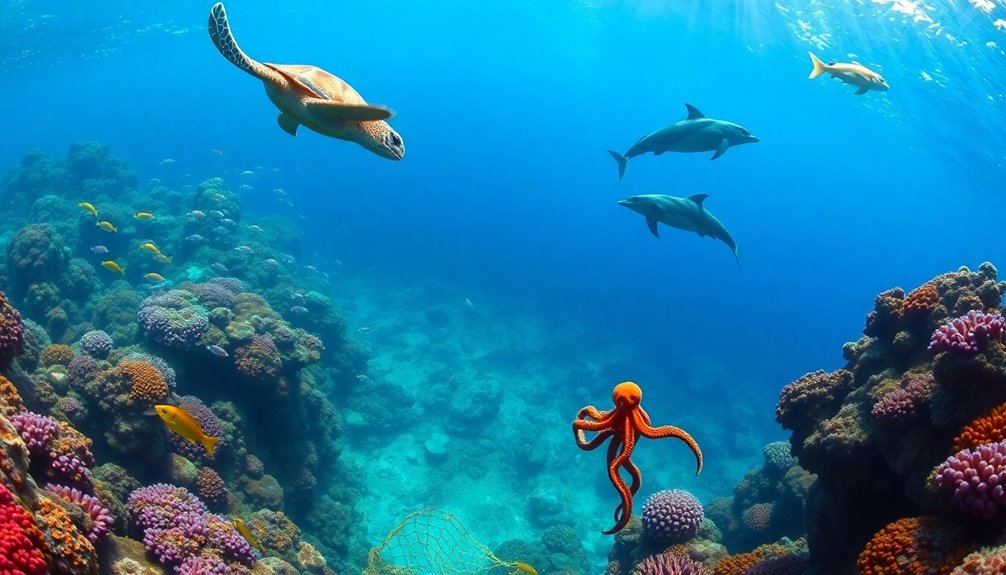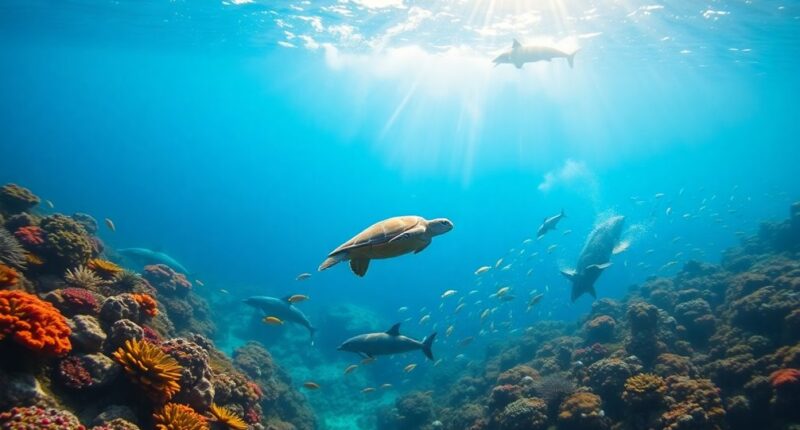Marine animals help tackle issues plaguing our seas by maintaining the balance of ecosystems. They regulate fish populations, which supports biodiversity and healthy habitats. Some species even assist in breaking down pollution, while others play roles in nutrient cycling. However, threats like pollution and fishing practices endanger these crucial animals. By protecting marine life, you can contribute to resolving these sea issues. Discover how your actions can make a difference in the ongoing fight for ocean health.
Key Takeaways
- Marine animals, through their natural behaviors, help maintain healthy ecosystems, contributing to the balance necessary for resolving oceanic issues.
- Species like sea turtles and whales aid in nutrient cycling, promoting marine biodiversity and enhancing the resilience of ocean habitats.
- Healthy populations of marine predators control the abundance of prey species, preventing overpopulation and ensuring ecological stability in marine environments.
- Research shows that marine mammals can indicate environmental health, guiding conservation efforts and policies aimed at reducing pollution.
- Engaging communities in marine conservation fosters stewardship, as understanding the role of marine animals encourages collective action against pollution and habitat loss.

As you explore the vast oceans, you might be surprised to learn how deeply marine animals are affected by pollution, particularly plastics. These materials wreak havoc on marine life, leading to entanglement and ingestion, which can be fatal for many species. From tiny zooplankton to majestic whales, the impact of plastic debris is pervasive. Microplastics, which break down from larger plastic items, find their way into the diets of various marine animals, disrupting growth and reproduction. Studies indicate potential effects of microplastics on growth rates and fertility of marine species, highlighting the urgent need for action.
Entanglement in fishing gear poses a significant threat to marine mammals. When animals become trapped, they often face dire consequences, including injury or death. Vessel strikes and pollution further compound their struggles, creating distress that can change their behaviors and habitats. It's crucial that you report any stranded or injured animals; trained responders can provide the necessary assistance while gathering vital data that reveals the impacts of human activity on marine ecosystems.
Entanglement in fishing gear threatens marine mammals, causing injury and altering behaviors; report stranded animals for vital assistance and data collection.
Marine life faces numerous threats, including harmful fishery interactions, which often lead to unintended catches and injuries. Chemical contaminants also pose risks, as many marine animals consume prey laden with toxins. These pollutants accumulate in the food chain, ultimately affecting human health as well.
A global effort is essential to tackle marine pollution, and organizations like The Marine Mammal Center and The Ocean Cleanup are leading the charge. They aim to reduce ocean trash, improve waste management, and advocate for the elimination of single-use plastics.
Conservation initiatives thrive on community involvement, and protecting marine biodiversity is vital. Innovative techniques like biologging, where sensors are attached to animals, enhance our understanding of human impacts on marine life. This data helps shape policies and conservation strategies, ensuring that we can effectively monitor and protect our oceans.
Every action counts, and by staying informed, you can contribute to the ongoing efforts to save marine animals and resolve the issues plaguing our seas.
Frequently Asked Questions
How Do Marine Animals Communicate With Each Other?
Marine animals communicate using various methods.
You'll notice that they utilize sound, with whales and dolphins producing clicks and whistles to convey messages. They also rely on chemical signals, like pheromones, for mating and social interactions.
Visual cues, such as body language or bioluminescence, help them connect at close range. Lastly, physical actions, like breaching or tail slapping, serve as signals within their complex social groups, enhancing their interactions in the ocean.
What Are the Most Endangered Marine Species Today?
Today, the most endangered marine species include the vaquita, with fewer than 30 individuals left, and hawksbill turtles, critically endangered due to overfishing and habitat loss.
Whale sharks and blue whales also face threats, with their populations significantly declining.
Climate change, pollution, and habitat destruction contribute to these challenges.
If you care about marine life, staying informed and supporting conservation efforts can make a difference in protecting these vulnerable species.
How Do Ocean Currents Affect Marine Life?
Ocean currents are the lifeblood of marine ecosystems, shaping life beneath the waves like a master artist. They guide majestic whales and turtles on their epic migrations, while also transporting vital nutrients that nourish diverse marine life.
You'll find that currents regulate temperature and salinity, ensuring a balanced environment. However, if climate change disrupts these currents, it could spell disaster, impacting food webs and the survival of countless marine species.
Can Marine Animals Adapt to Climate Change?
Yes, marine animals can adapt to climate change, though it's a complex process.
You'll notice some species adjusting their metabolic rates or changing breeding times to cope with warmer waters. Others might migrate to cooler areas or develop stronger shells due to ocean acidification.
These adaptations often involve intricate biochemical changes, allowing them to survive in increasingly challenging environments.
However, their ability to adapt varies widely among species, influenced by genetic diversity and environmental pressures.
What Role Do Humans Play in Marine Animal Conservation?
You're the lighthouse guiding change in marine conservation. Your actions ripple through oceans, shaping ecosystems.
By advocating for sustainable practices, you help protect fragile habitats. You educate others, planting seeds of awareness that blossom into collective action.
Volunteering for cleanups, you become a steward of the sea, while supporting conservation organizations ensures their vital work continues.
Your choices today weave a tapestry of hope for marine life, creating a future where oceans thrive.
Conclusion
Marine animals play a crucial role in addressing the challenges our oceans face. Did you know that healthy fish populations can help maintain coral reefs, which support 25% of all marine life? By protecting these creatures, you're not just preserving their habitat but also fostering a balanced ecosystem. Every small action you take can contribute to their survival and, in turn, the health of our seas. Together, we can make a significant difference for our oceans and their inhabitants.









